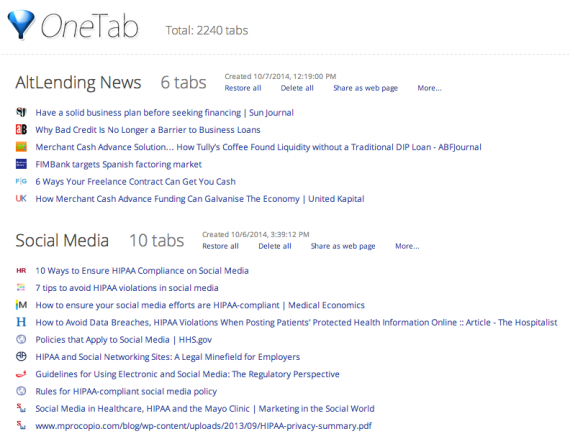In the ten years since I started blogging, I have honed a process for researching, writing, and editing. I have experimented with many tools in an effort to expedite it all. Here are ten that I recommend, along with where they fit in the blogging process. Using these tools could help you become a better ecommerce blogger.
1. Google
As obvious as it sounds, Google is an ideal place to begin research on a topic. Don’t limit yourself to search, however. Google offers a variety of tools including News, Blog Search, Trends, Images and more. Throw YouTube and Google+ into the mix, as well.
The primary reason I use Google Images is not for the sake of the images themselves. (Copyright laws forbid the unauthorized image use.) Often, an image is tied to an article or blog post from which I can gain information and inspiration.
To find the source, click on the image. A new window opens that contains a link to the web page where it is located.
2. One Tab
During this research phase, it is not unusual for me to have as many as 20 or 30 browser tabs open at one time. Going from tab to tab can be confusing, which is where a simple tool called One Tab comes in handy.
A Chrome and Firefox browser extension, One Tab complies all those tabs into an easy-to-follow list, greatly simplifying the research process.
As I come across what appears to be relevant content, I open it in a new browser tab. Once a set of tabs is open, I commit them to One Tab and then visit each in greater detail. If I determine that a piece of content lacks relevance, I can delete it from the list, further refining the process.
One Tab allows groups of tabs to be combined into a single list, which can be labeled by topic or category to aid in organization and exported as a web page in the event I need to share them with others. When I’m done with a list, I can delete it.
3. Twitter
No better tool exists for finding information than Twitter. Use Twitter Advanced Search to filter information by keyword, hashtag, @username, and more.
Don’t be surprised if you find several people linking to the same URL in their tweets. That gives you insight as to its importance and possible relevance for your post.
4. LinkedIn
Being a B2B blogger, I find that LinkedIn provides a wealth of content either written or referenced by those with whom I am connected. Since many of my connections share the same interests as me, it’s not difficult to find plenty of content to draw upon.
5. Notepad and TextEdit
Over the years, I have found that using a barebones tool like Notepad (Windows) or TextEdit (Mac) provides a blank document, enabling me to gather information and jot down notes, which I later refine into the finished product.
By selecting the plain text editing mode, I can strip away any concern over formatting, which might accompany the use of a blogging platform or Word doc, and focus strictly on the words themselves.
6. Evernote
Though I have never become a dedicated Evernote user, many bloggers rely on it as a primary source for research and basic blog post construction. Therefore, I it deserves a place on this list.
Evernote saves clipped content into individual notes, which can be combined into topically relevant notebooks.
Michael Hyatt, a well-known leadership consultant, calls Evernote his “blogging workbench,” and uses it to store blog post ideas, collect post components, and then write the post itself.
7. Microsoft Word
Once I have formed the collection of information and notes into a first draft using the text editor, I copy and paste it into MS Word. At that point, I further refine the text, and format it using category headings, sub-headings, paragraphs and lists. I also embed hyperlinks into anchor text and properly cite sources from which I excerpt content.
8. Grammarly
The final stage of the editing process involves the use of Grammarly, a grammar checking software platform.
Grammarly finds mistakes such as the use of passive voice, incorrect vocabulary, verb-tense errors, and much more. It also comes with vocabulary enhancement and plagiarism features that help ensure the post is well written with sources that are properly cited.
9. Pixlr
Not being a Photoshop expert, I rely on a cloud-based tool, Pixlr, to do basic image editing. Using it, I can reduce the image size, crop photos, combine multiple images into layers, and even add some cool filters, similar to those in Photoshop.
Pixlr offer three different versions.
- Pixlr Editor. A robust version that offers the most complete set of editing features.
- Pixlr Express. A useful for quick fixes.
- Pixlor-o-matic. Adds retro and vintage effects, similar to Instagram.
10. WordPress
Only after completing these steps do I commit the post to WordPress., my blogging platform.
A majority of my posts are long-form and often formal in tone, and I find that WordPress is best suited to that approach. Depending on your blogging style, other platforms may better fit your needs.
One of the reasons I prefer WordPress is its ability to interpret content copied from Word and strips out the extraneous HTML and CSS code that often bloats a Word doc. Plus, WordPress comes with many rich-text editing features all its own.
Finally, before hitting the “Publish” button, I save the post in draft mode, and then preview it to ensure that it meets my standards.









